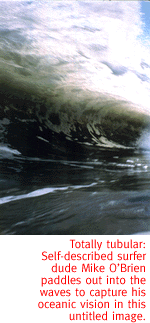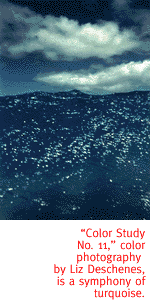

|

The Current Exhibition At The Center For Creative Photography Offers Visions Rich And Strange.
By Margaret Regan
IN SHAKESPEARE'S LATE play The Tempest, Ferdinand laments
his father's death by drowning at sea. But a song drifting over
the waves comforts him with these curious words: "Full fathom
five thy father lies/...Nothing of him that doth fade/but doth
suffer a sea-change/Into something rich and strange."
 The beloved father's body has metamorphosed into the sea's treasures,
his bones into coral, his eyes into pearls. An exhibition at the
Center for Creative Photography has borrowed a fragment from these
beautiful lines as a title for a show that navigates a parallel
metamorphosis in contemporary photography. Sea Change: the
Seascape in Contemporary Photography is a wonderful show that
convincingly demonstrates that in the late 20th century, serious
artists have turned their attention once again to the sea.
The beloved father's body has metamorphosed into the sea's treasures,
his bones into coral, his eyes into pearls. An exhibition at the
Center for Creative Photography has borrowed a fragment from these
beautiful lines as a title for a show that navigates a parallel
metamorphosis in contemporary photography. Sea Change: the
Seascape in Contemporary Photography is a wonderful show that
convincingly demonstrates that in the late 20th century, serious
artists have turned their attention once again to the sea.
In venturing into the seascape, they're undeterred by the sea
clichés in art, by the sailboats and crashing waves that
are a "required decor in seaside motels," as curator
Trudy Wilner Stack writes in her catalog essay. No, the 18 photographers
unashamedly take pictures of water and foam and beach, of sky
and infinite horizon. Yet they bring to their ocean explorations
a modernist aesthetic at odds with the Sunday school of sea art:
Their pictures are by turns minimalist or abstracted, chopped
up and reassembled. They may be beautiful, but they're never sentimental.
Aided partly by new technology, by cameras that don't mind a dunk
in the briny deep, such photographers as Liz Deschenes (born 1966)
and Michael O'Brien (born 1962) get right out in the surf and
shoot the waves all around them in brilliant color. Their pictures
are purely sensory, giving viewers by proxy that exhilarating
sense of being alive one draws from the ocean. In Deschenes' "Color
Study No. 11," or O'Brien's untitled picture from 1995, you
feel the slap of a wave, the salt in your eyes; you remember what
it's like to be buoyant and to be somersaulted upside down by
the rollers. "Color Study No. 11" is a symphony in turquoise
that pictures a shimmering wave rising up, about to break.
 O'Brien, a self-described surfer dude, rides out on his surfboard
to the breakers, and shoots just before the wave rolls over. In
his works, the spray against the sky, the curl of the wave, the
stillness of the water below achieve some of the majesty of Asian
landscape paintings.
O'Brien, a self-described surfer dude, rides out on his surfboard
to the breakers, and shoots just before the wave rolls over. In
his works, the spray against the sky, the curl of the wave, the
stillness of the water below achieve some of the majesty of Asian
landscape paintings.
But as sea lovers know, the ocean isn't always slap and dash.
It's a point of tranquillity, its beaches a place for hours of
dreamy reflection. Iain Stewart exhibits a series of nine incorporated
color prints that explore the sea's capacity to mesmerize. Lined
up in a row, the photos are almost abstractions, horizontal rectangles
divided into sky above and sea below. Delicately tinted in blues
to grays, they chart the most minute changes in color and atmosphere.
A bench is placed nearby and you just want to sit there and contemplate
the movements suggested by the pictures' titles, "Rhythm,"
"Shift," "Return."
Other photographers have issued sharper challenges to convention.
Hiroshi Sugimoto, a Japanese photog who now lives in New York
City, almost makes the sea disappear in a series of five, velvety
dark gelatin silver prints. Like Stewart, Sugimoto converts the
two bars of sky and sea into geometric horizontal bands, but Sugimoto
comes closer to minimalist black paintings, with only faint concessions
to content. Fernando La Rosa, a Peruvian accustomed to foggy Lima,
disrupts the clear air of other seas with blurry lenses that introduce
a vertical line ("Gulf of Mexico"), or else serves them
up piecemeal. In "Four Squares, Jamaica," he's covered
up the sea with a cloth or paper: We get only four postcard-size
glimpses through holes in the cover.
Robbert Flick goes further in an attack on the sea's eternal
horizontals. In "Surf1.Var2," he's cut up pictures of
rolling waves into 48 tiny rectangles, and reassembled them into
a grid. The Starn twins, Doug and Mike, defy the notion of the
sacred print with scotch tape. Their "Ocean in Fog,"
a toned gelatin silver print that edges toward sepia, is a series
of small prints taped together. The work is an alluring panorama
of choppy waves, receding from darkness in the foreground to pale
fog in the distance.
 Why the sea, and why now? Wilner Stack, who conceived the show
and borrowed mostly from artists and galleries to assemble it,
suggests that in an age of environmental degradation artists are
attracted by the undeniably raw power of the pure ocean. The photographers
certainly have turned their backs on our desecrated shorelines,
on the cheap amusements and expensive condos, sewage plants and
trash barges that sully the sea's waters.
Why the sea, and why now? Wilner Stack, who conceived the show
and borrowed mostly from artists and galleries to assemble it,
suggests that in an age of environmental degradation artists are
attracted by the undeniably raw power of the pure ocean. The photographers
certainly have turned their backs on our desecrated shorelines,
on the cheap amusements and expensive condos, sewage plants and
trash barges that sully the sea's waters.
Shooting from their vantage points on shore, in the shallows
and in the deep, these photographers locate in their viewfinders
no boats, no people, not even any birds. They venture out to where
the sea is new. Like Turner, the painter who found the sublime
in the ocean's misty atmospherics, the new sea artists make of
the sea something rich and strange indeed. 
Sea Change: The Seascape in Contemporary Photography
continues through Sunday, May 24, at the UA Center for Creative
Photography, south end of the pedestrian underpass on Speedway,
east of Park Avenue. Gallery hours are 11 a.m. to 5 p.m. Monday
through Friday, and noon to 5 p.m. Sunday.
Three free lectures are scheduled: Roni Horn, an artist
in the exhibition, will speak in the center's auditorium at 5:30
p.m. Friday, April 17. Eugenia Parry, a writer and adjunct
professor of art at the University of New Mexico, will give a
talk titled Too Deep for Tears: The Sea as a State of Mind
at 5:30 p.m. Tuesday, April 21, in the architecture auditorium.
Ed Glenn, UA professor of soil, water and environmental
science, will speak on Our Changing Seas at 5:30 p.m. Tuesday,
April 28, in the gallery. For more information, call 621-7968.
|
 |





